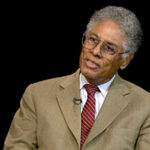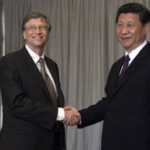
Oppressed and Oppressor: Historical Revisionism
Refuting the black armband approach to history:
Those who know a bit about Marxism might know that Lenin made much of the notion that – simply put – nations that are wealthy today became so by oppressing and ripping off other countries, which is why they in turn are poor today. Lenin’s theory of imperialism goes back to his 1916 essay on the issue, “Imperialism, the Highest Stage of Capitalism.” And critical theory follows on from this, dividing the world between the oppressors and the oppressed.
These views still dominate in many Western universities today, and whenever things like Columbus Day in America occur (just held again on October 12), or Australia Day in Australia (January 26), they increasingly are known as “Invasion Day” and the like, with the notions of ‘white man bad, indigenous populations good’ becoming increasingly more pronounced, with calls for national ‘sorry days’ being demanded.
Thus far too many Americans now believe Columbus was evil and he cruelly invaded America, while too many Aussies feel the same about Captain Cook and others who came here. So an entire industry now exists where all forms of European colonialism are seen as wrong, and all whites must apologise and make reparations for their treatment of past peoples and cultures.
I have discussed this often, especially when the Voice debate was held here a year ago – and lost when Australians overwhelmingly voted it down. In one article I mentioned a very significant volume by Nigel Biggar, Colonialism: A Moral Reckoning (William Collins, 2023). See that piece here: https://billmuehlenberg.com/2023/09/16/colonialism-and-the-voice/
Around the same time that Biggar’s book was released, another important volume examining the same issues in great detail appeared: Not Stolen: The Truths about European Colonialism in the New World by Jeff Flynn-Paul (Bombardier Books, 2023).
He too offers us a very carefully constructed rebuttal of the anti-West narratives that so dominate many of the chattering classes and academics of today. The history lecturer at the University of Leiden gives us plenty to think about in his 400-page work, reminding us that too much of what we have heard about Europe and the West, the age of exploration, colonialism, and individuals like Columbus has been given a very bad – and skewed – rap.
As with Biggar’s volume, he does not for a moment play down or minimise very real wrongs committed by Europeans during this period. He does not whitewash them, but he does challenge the radical leftist critiques that have sprung up over recent decades, including the influential but quite flawed 1980 volume, A People’s History of the United States by Howard Zinn. These and other words have resulted in a major change in how people perceive global history:
Europe and the West used to be revered not only as the cradle of democracy, but as the home of the Renaissance, the Scientific Revolution, the Industrial Revolution, constitutional government, women’s suffrage, global abolitionism, the Geneva Conventions, the United Nations, human rights, the research university—in short, the foundation of much that is good in modern life. Buoyed by social media successes, activists have worked tirelessly to cast European society in as negative a light as possible. They have also downplayed the numerous historical horrors that were perpetrated by non-Europeans, including the horrors of slavery within Africa, the horrors of Islamic slavery in Africa—which saw up to ten million Africans trafficked across the Sahara over many centuries—of modern genocides in Asia that have created tens of millions of victims, of longstanding antifeminism in India, and a host of truly awful histories besides. The activist campaign against Europe and Europeans has been so successful that even the likes of Beethoven and Sir Isaac Newton are now considered monsters by many on the Left.
Show me a historian who lacks a healthy skepticism of fads like critical theory and I’ll show you a historian who is not doing their job. They can be as contrary as they want—but facts, rather than ideology, must come first for their work to qualify as science rather than propaganda. (xxii-xxiii)
In meaty and well-documented chapters he argues against this distorted view of history which charges Europeans with just about every evil under the sun, including racism, genocide, slavery, mass murder, exploitation, cultural appropriation, and imperialism. And again, he does not downplay genuine evils done by Europeans, but seeks to set the historical record straight as he debunks the hysterical hyperbole and over-exaggeration of what Europe’s past was really like.
Consider the claims so often heard by radical leftist historians and commentators that the indigenous peoples were not only as advanced and cultured as Europeans have been, but that these cultures were really peaceful and benign. They say that it was the Europeans who came along and violently disrupted these tranquil and benevolent societies.
Thus for example the leftist revisionists sought to remake the image of Native Americans from proud warriors to basically a bunch of early hippies and tree-huggers. But inter-tribal warfare was commonplace, and violence within and without tribes tended to be the norm:
There is one small problem with this image of peace-loving Native American societies: it is completely untrue. Before the Spanish imposed peace on Amerindian tribes from California to Tierra del Fuego, the unrelenting reality of their lives was a Hobbesian war of all against all. (The parallel with Rome, which imposed a similar peace through violence on the Gauls and other tribal peoples of Western Europe, is striking in this regard.) Outside of a tiny area of city-states in Mesoamerica and the Andes, Native American societies were uniformly tribal chiefdoms. Wherever in the world such city-states and chiefdoms have arisen, warfare has been a continuous part of life. As a rule, the majority of males in chiefdoms are trained in the art of war; in city-state areas, elite males train in war while the rest of the males participate in agriculture or crafts that support the warrior elite.
There are very few general truths in the history of global civilization, but one of the most reliable is that in areas where rulers monopolize violence on a small scale, warfare, raiding, and slavery will be endemic…. (p. 137)
In addition to what was so often constant warfare, there are other issues to explore, such as indigenous cannibalism and infant sacrifice. As to the former, Flynn-Paul says this:
It is a well-established fact among anthropologists and historians that many tribal groups around the world have engaged in cannibalism; this was far more common than squeamish first-world academics want to allow. Cannibalism was common for a very simple reason. In hunter-gather societies, protein is always at a premium, and eating one’s enemies might well make the difference between survival and extinction. Other reasons for cannibalism include intimidation, the building of a reputation for fierceness in battle, and also a sort of ritual in which one dominates one’s enemies utterly, while appeasing some sort of divine command. (p. 142)


And child sacrifice was certainly not uncommon among so many of these indigenous peoples:
Human sacrifice has been practiced all over the world: in ancient China, among the ancient Celts and the pre-Christian Scandinavians, and in West Africa before the Europeans arrived. The New World was no exception.
The practice of human sacrifice developed in South and Mesoamerica over the course of many centuries. During the classic Maya period (before AD 900), human sacrifice was common, but it was apparently done on a modest scale. Religious beliefs suggested that blood ensured renewal, and sacrifice was required in order for the gods to continue to perpetuate creation.
With the rise of the Aztecs, cities became larger, and the ritual apparatus of the state became larger still. Accordingly, the number of sacrifices ramped up significantly. . . . Credible authorities believe that the number of human sacrifices at the Aztec capital topped twenty thousand per year, with satellite cities sacrificing smaller yet still significant numbers. If the Aztec capital of Tenochtitlan contained some two hundred thousand people in 1491, this suggests that a number of captives and slaves equal to fully 10 percent of the population of the city was sacrificed each year. Most of their corpses were dismembered and distributed as food to members of the population, often depending on their social status. (pp. 144-145)
Then one can also discuss the issue of slavery which was widely practiced by non-whites and non-Europeans:
Many accolades, including the coveted Bancroft Prize, have recently been heaped on a book called The Other Slavery, which catalogues the Amerindians who had been enslaved by Europeans over the course of the colonial era.” This despite the general prohibition by most European governments against the enslavement of Indians. What these self-congratulatory academics obstinately ignore is the other slavery—the simple, incontestable fact that Indians enslaved far more Indians than Europeans ever did. It is likely that more Africans were enslaved by Indians in the New World, than Indians by Europeans. Next to no academics are brave enough to do research on important topics such as this for the simple reason that their colleagues do not want to hear the whole truth about Indigenous slavery. Partly in order to supply the huge markets for sacrificial victims… (p. 147)
All that comes from just one chapter in this book. Anyone reading the book all the way through will see without a shadow of doubt that we in the West have been fed a bill of goods when it comes to the West and its past. Was it without fault? Of course not. But it was nowhere near as bad as the critical theorists and haters of the West make it out to be.
Flynn-Paul ends his volume by looking at contemporary challenges, including the now oft-heard demands for reparations. He begins his chapter on this subject with these words:
Opportunists across the world are using the distortion of global history to agitate for the redistribution of wealth, land, and political power to “indigenous tribes.” They recognize that the wave of guilt spread by critical theory has created an historic opportunity for personal gain that might never be seen again….
The weaponization of history by identity activist stands to gain a handful of people trillions of dollars worth of capital to the detriment of nearly everyone else. (pp. 364-365)
He spends the rest of the chapter looking in detail at how Native Americans are faring thanks to government (tax-payer) largesse:
It is estimated that about one-fifth of all Americans receive welfare benefits and that average payout is about $35,000 per year. . . . Meanwhile, Indians living on reservations are eligible for a combination of state-level welfare plus federal and tribal benefits accorded above. The total package of Native American benefits, even for those who are not eligible for state-level welfare, can easily exceed the compensation received by non-Native welfare recipients.…
The land controlled by American Indian tribes today is often dismissed as negligible, but this is mere posturing. As their reservation system was finalised in the later 1800s, Native Americans remained in possession of some 2.3% of all United States land, even though they numbered less 0.3 per cent of the US population at the time. . . . That land, at over 2 per cent of the US property market, is today valued at $700 billion. Hardly a drop in the bucket. (pp. 372-373)
While this volume does not deal with the Australian situation as the Biggar volume has, both are vitally necessary works to dispel the black armband view of history, as Australians refer to it. On balance, Europe and European colonialism has been a force for good in the world, and we must reject the lies and misinformation of the enemies of the West.
[1946 words]



















